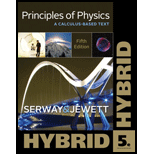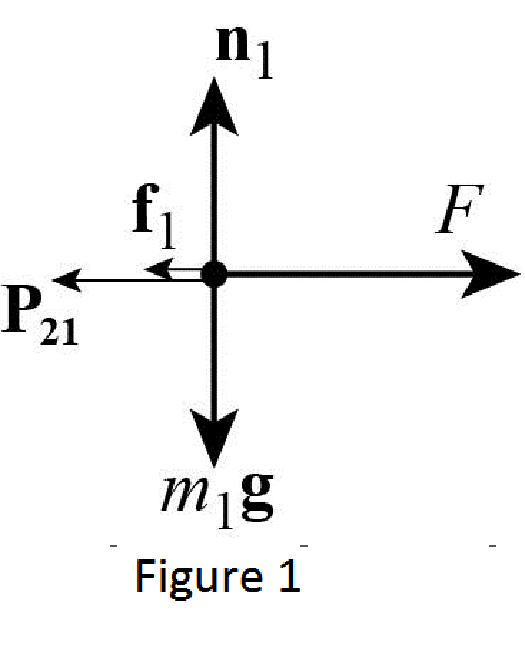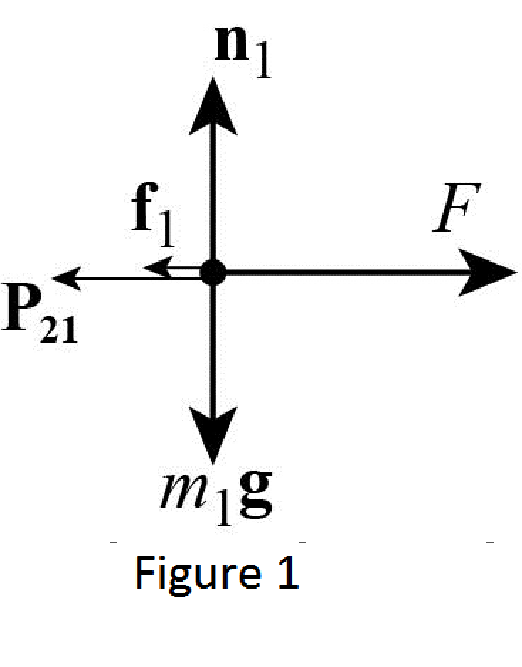
Concept explainers
(a)
Draw free body diagram of each block.
(a)
Answer to Problem 53P
The free body diagram of mass

The free body diagram of mass

Explanation of Solution
The free body diagram is the graphical illustration used to visualize the movements and forces applied on a body.
Let
The free body diagram of mass

The free body diagram of mass

Conclusion:
Therefore, the free body diagram of mass
(b)
The net force on the system of two blocks.
(b)
Answer to Problem 53P
The net force on the system of two blocks is
Explanation of Solution
From the Figure 1, write the expression for net force action on the mass
Here,
From the Figure 2, write the expression for net force action on the mass
Here,
So the net force on the system is the sum of net force on the each block.
Since contact force acting on each mass is equal.
The net force on the system of block is equal to the magnitude of force
Conclusion:
Therefore, the net force on the system of two blocks is
(c)
The net force on the mass
(c)
Answer to Problem 53P
The net force on the mass
Explanation of Solution
From the Figure 1, write the expression for net force action on the mass
The net force on the mass
Conclusion:
Therefore, the net force on the mass
(d)
The net force acting on the
(d)
Answer to Problem 53P
The net force acting on the
Explanation of Solution
From the Figure 2, write the expression for net force action on the mass
The net force acting on the
Conclusion:
Therefore, the net force acting on the
(e)
Newton’s second law in the
(e)
Answer to Problem 53P
Newton’s second law in the
Explanation of Solution
The blocks are pushed to the right, the acceleration on each block is same and the block exerts equal and opposite forces on each other, so these forces have the same magnitude.
Write the expression for Newton’s second law in the
Here,
Write the expression for frictional force.
Here,
Use equation (III) and (IV) in (I).
Use equation (III) and (IV) in (II).
Conclusion:
Therefore, Newton’s second law in the
(f)
Acceleration of the blocks.
(f)
Answer to Problem 53P
Acceleration of the blocks is
Explanation of Solution
Add equation (V), and (VI), and solve for
Conclusion:
Therefore, the acceleration of the blocks is
(g)
The magnitude of contact force
(g)
Answer to Problem 53P
The magnitude of contact force
Explanation of Solution
Solve equation (IV) for
Use equation (VII) in (VIII).
Simplify the equation (IX).
Conclusion:
Therefore, the magnitude of contact force
Want to see more full solutions like this?
Chapter 5 Solutions
Principles of Physics
- Let us make the (unrealistic) assumption that a boat of mass m gliding with initial velocity v0 in water is slowed by a viscous retarding force of magnitude bv2, where b is a constant, (a) Find and sketch v(t). How long does it take the boat to reach a speed of v0/l000? (b) Find x(t). How far does the boat travel in this time? Let m = 200 kg, v0 = 2 m/s, and b = 0.2 Nm-2s2.arrow_forwardA block with mass m sits on a frictionless plane inclined at angle θ, as shown in the figure. If the plane is accelerated to the right with the proper acceleration that causes the blockto remain at the same position with respect to the plane, what is the normal force between the block and the plane? a. mg b. mg sin θ c. mg cos θ d. mg/cos θarrow_forwardA 3.5 kg particle moves along an x axis according to x(t) = −12 + 5t2 − 4t3, with xin meters and t in seconds. In unit-vector notation, what is the net force acting on theparticle at t = 6 s?arrow_forward
- One paint bucket of known mass mA = 10.0kg is hanging by a massless cord from another paint bucket of known mass mB = 15.0kg, which is hanging by a massless cord. If the two buckets are pulled upward with a known acceleration of a = 2.0m/s2 by the upper cord, calculate the tension in cord 1 and the tension in cord 2 by (a) selecting appropriate common equations and making appropriate substitutions for the symbolic answer. (b) show the numeric substitution of given quantities for the final result. (c) Draw a free body diagram for each bucket.arrow_forwardA block of mass m1 = 2.5 kg moving on a rough surface is connected by a light inextensible cord passing over a light frictionless pulley to a hanging block of mass m2 = 8.0 kg. The coefficient of kinetic friction between the surfaces of the block and the table is μk = 0.27. See figure attached. Determine a) the normal reaction on block 1,b) the acceleration of the blocks, andc) The tension, T, in the cord. Incase the blocks on the diagram aren't clear, they both say M2 (subscript 2) Please include formulas.arrow_forwardThree forces act on an object, considered to be a particle, which moves with constant velocity v =(3 m/s)î +(−2 m/s)ĵ Two of the forces are shown in the picture below., while the third force, F_3 is not given. 1.) What are the x, y, and z components of F_3?arrow_forward
- An elevator, complete with contents, has a mass of 2000.0 kg. For each of the two situations described in a) and b) below, do the following. - Draw a free-body diagram showing the correct relative lengths of the Tand the F vectors. - Determine the value of T (the tension in the elevator cable). - State the value of the real weight and the apparent weight in each case. • a. The elevator is moving up at a constant velocity of 2.0 m/s. • b. The elevator is moving up at a constant acceleration of 1.0 m/s squared?arrow_forwardWhat net external force is exerted on a 1400-kg artillery shell fired from a battleship if the shell is accelerated at 300×104 m/s22.40×104 m/s2? What is the magnitude of the force exerted on the ship by the artillery shell?arrow_forwardIn experiment 1, a cart (M1) is placed on a frictionless horizontal surface and attached by a rope to a vertical hanging mass (m1). In experiment2, the mass of the cart is doubled (M2=2M1). What relationship must exist between the two hanging-masses to ensure that the system acceleration is the same between the two experiments? Answer choices: a) m2=m1 b) m2=2m1 c) Impossible to determine without numerical values for each mass. d) m2=0.5m1arrow_forward
- If the vector components of the position of a particle moving in the xy plane as a function of time are x(t) = bt2 and y(t) = ct3, where b and c are positive constants, b has dimensions of length per time squared, and c has dimensions of length per time cubed, when is the angle between the net force on the particle and the x axis equal to 45°? (Use the following as necessary: b, c. Enter an answer greater than 0.)arrow_forwardA 2.8 kg mass is initially at rest while upon a horizontal surface. An applied force of 17 N is exerted on the mass in the =x direction. If the acceleration produced is 2.3 m/s² in the +x direction, what is the coefficient of kinetic friction between the mass and the surface?arrow_forwardAt t = 0, an object of mass m is at rest at x = 0 on a horizontal,frictionless surface. A horizontal force Fx= F0(1 −(2t/T), which decreases from t = 0 to t = T, is exerted on the object. Find an expression for the object’s velocity and position at time T.arrow_forward
 Classical Dynamics of Particles and SystemsPhysicsISBN:9780534408961Author:Stephen T. Thornton, Jerry B. MarionPublisher:Cengage Learning
Classical Dynamics of Particles and SystemsPhysicsISBN:9780534408961Author:Stephen T. Thornton, Jerry B. MarionPublisher:Cengage Learning Physics for Scientists and Engineers: Foundations...PhysicsISBN:9781133939146Author:Katz, Debora M.Publisher:Cengage Learning
Physics for Scientists and Engineers: Foundations...PhysicsISBN:9781133939146Author:Katz, Debora M.Publisher:Cengage Learning

